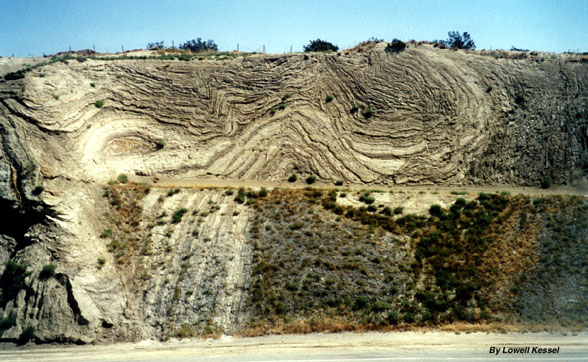A classic piece of advice for every new writer is, "Write what you know." What is produced on the page is a synthesis of all the various input the writers has tapped into. How we discover ourselves and the world around us shapes our way of thinking. One of the great American methods of experiencing our own country is the road trip. This country is so broad that there is no way to absorb it all in one lifetime. Unfortunately, for the writer of fantasy, the experience of roadside ecology is a lie.
The interstate highway system in the United States enables the car culture that exists today while transforming the landscape. I had a professor in college who called it the single greatest boon the government every gave geology. To understand what he meant, next time you're driving, take a gander at the many road cuts along the shoulder as you pass through a mountainous region. However, this does not give
 http://strike-slip.geol.ucsb.edu/KESSEL/palmdaleroadcut.html
http://strike-slip.geol.ucsb.edu/KESSEL/palmdaleroadcut.htmlthe observant passerby an accurate vision of what the world naturally looks like. The image included is a pretty spectacular example, but we have blasted many a mountain and hill to smooth the way for transit.
The system of roads in this country is also responsible for filling large areas of land. In my personal work on the New Jersey Turnpike around Newark Airport, I found swamp material immediately under the base material for the roadbed. This might not seem like a big surprise for fans of The Godfather, but it seems like the Meadowlands Arena would more properly have been named the Marshlands. Filling marshlands was popular through much of American history (well, we used to drain them, but that was harder). My old High School was built on fill material generated by local industry (which they remembered only when they broke ground the second time to expand it). The important thing to remember here is that the water still has to go somewhere, so it swells the size of nearby waterways (and also causes more damage during flood events).
Controlling the natural world on a large scale is one thing humans have worked on for a long time and not just to build roads. Recently it has been suggested that many of the rivers in the eastern US weren't created by nature, but by Colonial farmers. Specifically by damming streams to create mill ponds. Read more about it here (http://www.npr.org/templates/story/story.php?storyId=18228525). If you thought rivers always wanted to meander, don't feel bad. Until the associated article came out in the journal Science, geologists thought the same. The tradition of building ponds continues even today as we continue to seek more lakeside acreage for the watersport enthusiast.
A short form for all of this is simply: you can not trust all you see. Humans have long been altering the landscape to best fit our needs. In the natural world there are less clear passes through the mountains. Numerous marshy lowlands might befoul our adventurers' boots. Then again they may just go swimming in a mill pond. Fantasy civilizations will impact their worlds too.
No comments:
Post a Comment